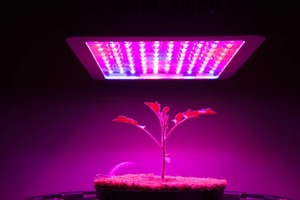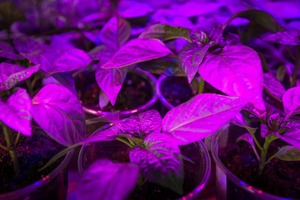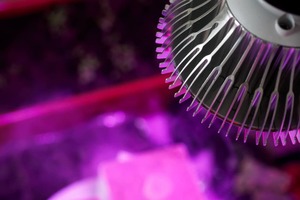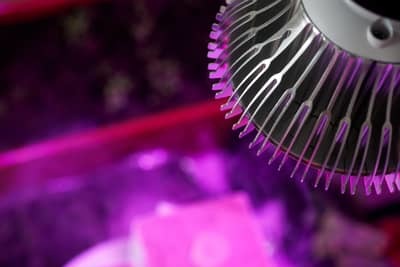Many people want to grow their own plants; it’s a great way to save money on vegetables and it’s always nice to smell the flowers after a stressful day! However, not everyone has the backyard for a garden or a place for their greenhouse. For those who do have these problems, growing plants indoors with LED grow lights works just as well.
LED grow lights work well when it comes to growing plants indoors. They’re useful for indoor greenhouses because they give indoor plants the light they need since the indoor plants don’t naturally get it from the sun.
Comparison between LED grow lights vs. other horticultural lights
|
Type of grow light |
pros |
Cons |
|---|---|---|
|
Incandescent grow bulbs |
least expensive |
|
|
Fluorescent grow lights |
|
Expensive |
|
LED grow lights |
|
Somewhat expensive, but a good long-term investment |
How to use LED grow lights
LED grow lights setup
To use LED grow lights, you’ll first need an indoor garden. Planting an indoor garden is easy. Find a space in your home that won’t be disturbed by small children or pets.
Then, fill containers up with soil. Either use plastic containers or wooden ones. Don’t stack your containers either. You’ll want to be sure that all of your plants get the light they need from the LED grow light.
In order for plants to properly grow, you want the LED grow lights to imitate the sun. In order to do this, place the lights above your plants. Grown outdoors, plants don’t receive sunlight from below or from the side!
Hang the LED grow lights exactly six inches over your plants. That distance ensures that your plants receive both the amount of light and heat that they need in order to photosynthesize and grow.
In order to hang your LED grow lights, you’ll need a standard rope ratchet. These can typically hold lights that weigh between 7 to 26 lbs. You’ll also want to use an “S” hook to hang the lights so that your plants receive the full spectrum of light, just as they would if they were planted outdoors.

LED grow lights & plant care
Make sure that the LED grow lights are about 12 inches above your plants. As the plants grow, you should adjust the grow lights accordingly.
I’d suggest measuring the distance between your plants & the grow lights regularly–every week or so. (How often will depend on the type of plant you’re growing).
Fast growing plants should be measured and adjusted more often than slower growing plants. Measuring and adjusting every few weeks can get tedious, but it’s important to ensure that your plants remain healthy.
When to replace
LED grow lights do last the longest compared to other grow lights, but they should be replaced every five to six years. They could burn out if you don’t, and your plants won’t receive the proper light or heat that they need to grow. You should pay attention to when the lights are getting old in order to keep your indoor plants healthy and growing.
LED grow lights maintenance
The lights should also be cleaned and dusted every week or so. This can get tedious, but it is important for indoor gardeners. Moths and other bugs are often attracted to such lights, and if they die in the lights, it can hinder the amount of light your plants are getting. You shouldn’t let the dirt or the deceased bugs build up too much, as it will block your plants from getting the light they need.
Do LED grow lights need to be turned off?
The LED grow lights should be turned off for about eight hours every day. Of course, it depends on the type of plant but no outdoor plants get sunshine 24/7! It should be the same for when plants are growing indoors. When you purchase plants to grow in your indoor garden, you should research how much darkness the plant typically needs, and how much light the plant typically needs. Timers for lights can be purchased for a relatively cheap price from any hardware store. The set up is easy and it’s a great solution to those who tend to forget to turn the lights off!
Recommended plants
Any plant can be grown indoors under LED grow lights. LED grow lights are designed to imitate the sun, so if they can be grown outside under sunlight, they can be grown indoors under LED grow lights!
In order to ensure your plants will grow well under LED lights, you should read the directions on the back of the seed packet. These will often tell you how much light your plants should get, which will tell you how long to turn the LED lights off for. It is recommended to use plants that all require the same amount of light so that none of them receive more than they need. If you plan on growing flowers, grow flowers! If you plan on growing vegetables, grow vegetables!
Plants that benefit most from LED grow lights
Virtually all indoor plants benefit from LED grow lights. Since the grow lights imitate the sun’s spectrum, any plant that grows under sunlight can also be grown with LED grow lights.

Benefits of LED grow lights
LED grow lights work well because they’re designed to imitate the sun. They give out minimal heat but provide both red & blue light that plants require.
In addition, grow lights emit very specific wavelengths of light, which is critical for plant growth. Compared to other grow lights, LED grow lights are by far the most efficient, because they conserve energy and they imitate the sun in a way no other indoor grow light does.
Why LED grow lights are important for indoor growth
Plants need light to grow and LED grow lights gives indoor plants the light they need that they don’t get from the sun. For various reasons, not everyone is able to grow an outdoor garden, but that shouldn’t mean that they can’t grow one at all. LED grow lights are essential for indoor plants to receive the light they need in order to grow healthy and strong.
LED grow lights: Cost
LED grow lights can cost from $300 to over $1,000. This depends on the size of the light. However, they only need to be replaced every 5 years, so the investment is worth it. Other lights, although cheaper, often need to be replaced much sooner and require more energy to use. LED grow lights may seem expensive at first, but they can end up saving an indoor gardener a lot of money!
LED lights are fairly efficient when it comes to saving energy. Typically, it costs about $8 a month to run LED grow lights. It’s just like a Netflix subscription! Of course, if you’re planning on growing plants that require longer exposure to light, it could cost a bit more to run them. In comparison, HID lights, lights that big corporations tend to use, can cost up to $30 a month to run.
Why you should use LED grow lights
Health benefits for plants from grow lights?
Of course, natural sunlight is always the best option when it comes to growing plants. However, LED grow lights are very effective when it comes to growing plants indoors. They imitate the sun better than any other grow light, so your plants will still be able to get the nutrients they need from LED grow lights.
Grow lights vs. Natural light
Grow lights imitate the sun, since the gives plants exactly what they need. (Well, except for water, oxygen, CO2, N-P-K, etc. But you get the point).
The sun’s light spectrum provides plants with the ability to photosynthesize and grow:
- The blue part of the spectrum provides leaf growth to the plant.
- The red part of the spectrum helps plants flower and grow fruit.
However, many indoor grow lights can’t copy sunlight exactly. That’s because not all grow lights emit both red and blue colors of the spectrum,
However, with the proper care, plants grown under LED lights tend to grow healthily and last a long time.
Horticulture LED grow lights emit the full spectrum of light that plants need. That way, plants are able to grow just as healthy as they would if they were grown outside. As long as the lights are the proper distance from the plant, and as long as they’re turned off during the night, the plants grown indoors should grow just as well as plants grown outdoors.

Related questions
How long should LED grow lights be on?
Typically, LED grow lights should be on for 16 hours per day. Most plants will need LED grow lights to be off for 8 hours every day. But it depends–you should always research the specific plant’s needs to be sure you’re giving your plants the right amount of light they require.
Do LED grow lights damage your eyes?
LED grow lights can actually damage your eyes. Since LED grow lights are designed to produce light from the sun, you should avoid staring directly at the light for an extended period of time. Using sunglasses with UV protection when working around LED grow lights can protect your eyes.
Can you use white LED lights to grow plants?
White LED lights can be used to grow plants, but they are less effective than using blue or red LED grow lights. That’s because white LED lights don’t provide a broad-spectrum light, which is important for plants to grow well.


